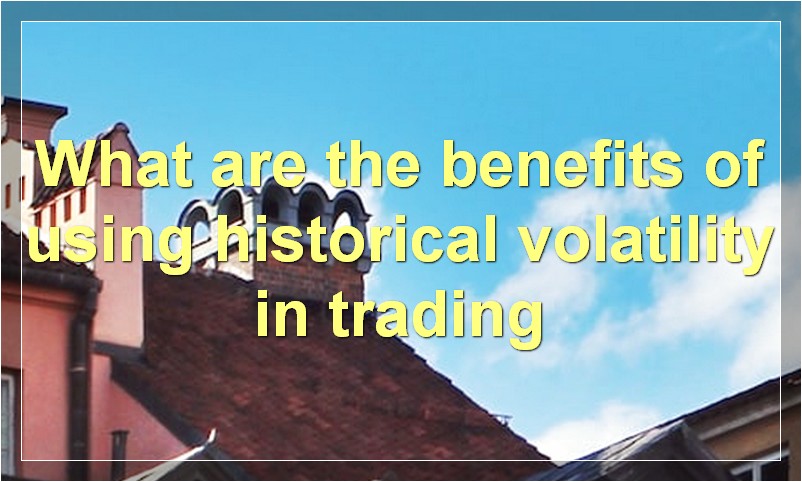Historical volatility is a measure of how much a security’s price has fluctuated over a given time period. It is important because it can give investors an idea of how volatile a security is and how much risk they are taking on by investing in it.
What is historical volatility
Historical volatility is a measure of how much a stock price has fluctuated over a certain period of time. It is calculated by taking the standard deviation of the stock’s return over a certain period of time.
Investors use historical volatility to gauge how risky a stock is. The higher the historical volatility, the riskier the stock is.
why is historical volatility important

Historical volatility is important because it can provide insights into future market behavior. By studying past market movements, investors can get a better sense of how the market might behave in the future and make more informed investment decisions.
When markets are volatile, it can be difficult to predict where they will go next. However, by looking at historical volatility, investors can gain a better understanding of how the market has reacted to similar situations in the past. This can help them make more informed decisions about where to invest their money.
Investors who are aware of historical volatility patterns can also use this information to their advantage. For example, they may choose to buy stocks when volatility is low and sell when it is high. By doing this, they can potentially make profits in both rising and falling markets.
Overall, historical volatility is a valuable tool that can help investors make more informed investment decisions. By studying past market behavior, investors can gain a better understanding of how the market might move in the future and make more informed investment choices.
How is historical volatility calculated
There are a number of ways to calculate historical volatility, but the most common is to take the standard deviation of daily price changes over a given period of time. This can be done using simple Excel functions, or more sophisticated statistical software.
The standard deviation is a measure of how much prices fluctuate around the mean, or average, price. It is calculated by taking the square root of the variance, which is the average of the squared deviations from the mean.
For example, if we wanted to calculate the historical volatility of a stock over the last 30 days, we would first take the prices for each day and calculate the average price. Then we would take the squared deviation of each price from the mean, and finally take the average of those squared deviations. The square root of that number would be the historical volatility.
There are other ways to calculate historical volatility, but this is the most common and it is a good starting point for understanding how prices move over time.
What factors influence historical volatility
Volatility is a measure of how much the price of an asset, such as a stock or commodity, fluctuates over time. It is often used as a measure of risk, as investors are typically more willing to take on volatile assets when they are expecting high returns.
There are a number of factors that can influence historical volatility, including:
-The overall market conditions: In general, markets are more volatile when there is uncertainty or when there are large swings in asset prices.
-The specific industry: Some industries are inherently more volatile than others, due to the nature of the businesses or the products they produce. For example, commodities tend to be more volatile than stocks.
-Geopolitical events: Major events happening around the world can have an impact on asset prices and volatility. For example, the Brexit vote in 2016 caused a great deal of volatility in the stock markets.
-Economic indicators: Changes in economic indicators (such as GDP or inflation) can also lead to increased volatility.
How can historical volatility be used in trading
Historical volatility is a measure of how much a security’s price has fluctuated over time. It can be used to predict how volatile a security’s price will be in the future.
Volatility is important for traders because it affects the amount of risk they are taking on. A security with high historical volatility is more likely to experience large price swings in the future, which means there is more risk involved in trading it. On the other hand, a security with low historical volatility is less likely to experience large price swings, which means there is less risk involved in trading it.
There are a number of ways to measure historical volatility. The most common method is to calculate the standard deviation of the security’s price over a certain period of time, such as the past year. This number can then be used to predict how volatile the security’s price will be in the future.
Another way to measure historical volatility is to look at the range of the security’s price over a certain period of time. This is done by calculating the difference between the highest and lowest prices that the security traded at during that period. The larger the range, the more volatile the security’s price is.
There are a number of factors that can affect a security’s historical volatility. Some of these include the overall market conditions, the sector that the security belongs to, and even world events. For example, if there is a lot of political instability in a country, this can cause the prices of all assets in that country to become more volatile.
What are the benefits of using historical volatility in trading

Historical volatility is a measure of how much a security has fluctuated in price over a given period of time. It is calculated by taking the standard deviation of the security’s return over the period.
Historical volatility can be used as a tool by traders to measure risk. It can also be used to predict future volatility. When combined with other technical indicators, historical volatility can provide a more complete picture of a security’s price movement.
Some benefits of using historical volatility in trading include:
1. It can help you measure risk.
2. It can be used to predict future price movements.
3. It can provide a more complete picture of a security’s price movement.
4. It can help you make better trading decisions.
What are the risks associated with historical volatility
Volatility is a measure of how much the price of an asset, such as a stock, commodity or currency, fluctuates over time. Historical volatility measures how much an asset has fluctuated in the past and is used by traders to gauge future price movements.
While historical volatility can be helpful in predicting future price movements, it can also be risky. This is because past performance is not necessarily indicative of future results. Volatility can also be affected by external factors, such as political and economic events.
Investors who are considering investing in volatile assets should do so with caution and be prepared for the possibility of losses. They should also diversify their portfolios to mitigate the risks associated with volatility.
How can traders use historical volatility to their advantage
Historical volatility is a measure of how much the price of an asset fluctuates over time. It can be used to predict future price movements and help traders make more informed decisions about their trades.
Traders can use historical volatility to their advantage by using it as a tool to predict future price movements. By understanding how volatile an asset has been in the past, traders can make more informed decisions about their trades and potentially profit from price movements.
What are some common mistakes made when using historical volatility
There are a few common mistakes that people make when using historical volatility. The first mistake is using too short of a time period. Historical volatility should be based on at least a year’s worth of data, and preferably longer. The second mistake is not adjusting for changes in the underlying asset. For example, if the stock price goes up, the historical volatility will usually go down. Finally, people often mistakenly think that higher historical volatility means higher future volatility. This is not necessarily the case – it all depends on the underlying factors driving the market.
How can historical volatility be used to predict future market movements
Historical volatility is a measure of how much the stock market fluctuates. It can be used to predict future market movements, but it is not the only factor that should be considered.

